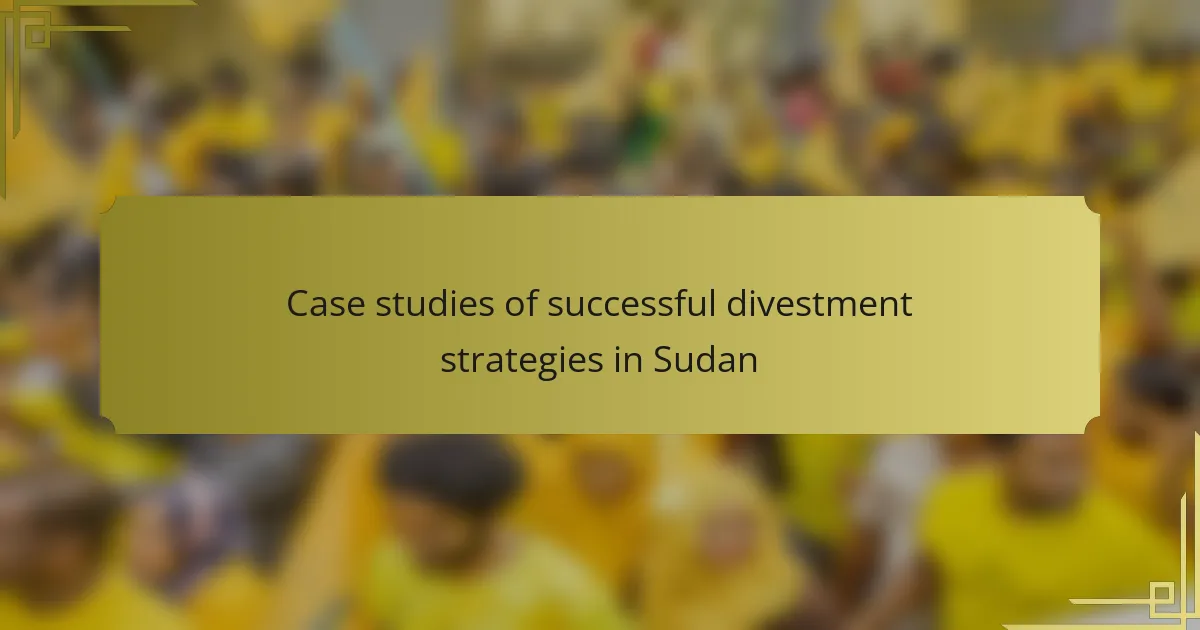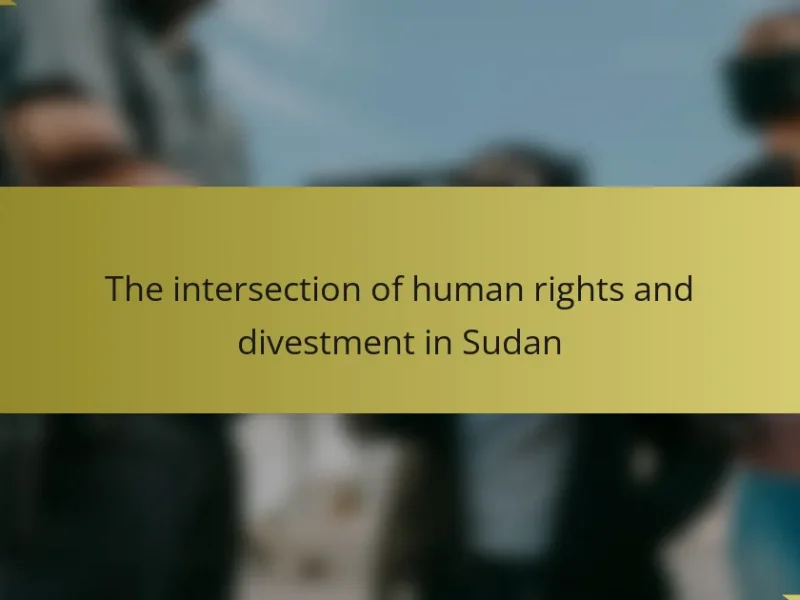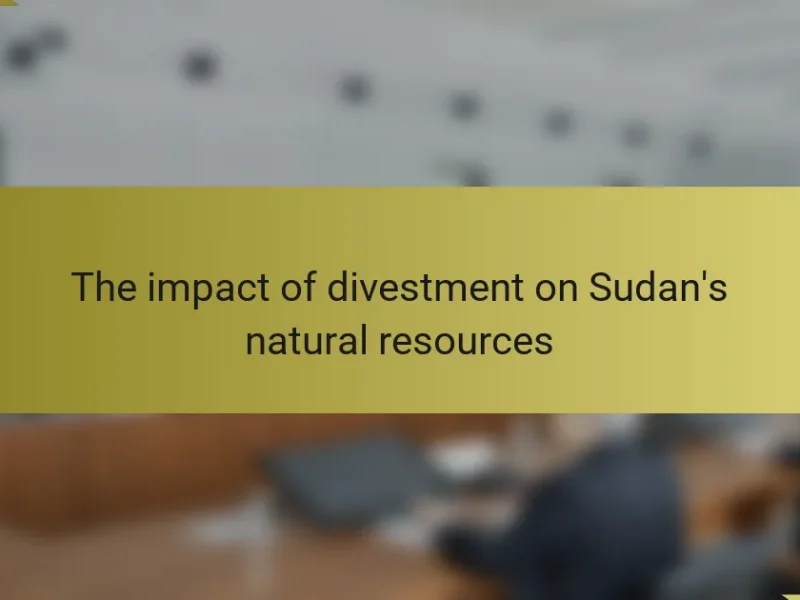The article examines successful divestment strategies in Sudan, focusing on the complex political and economic challenges that hinder these efforts. Key strategies highlighted include targeted sanctions against specific sectors, mobilizing international coalitions, raising investor awareness about human rights abuses, and leveraging legal frameworks to restrict investments. Notable case studies, such as the Sudan Divestment Task Force and the Norwegian government pension fund, illustrate the effectiveness of coordinated divestment efforts in promoting corporate social responsibility. The article also addresses the significant obstacles faced in implementing these strategies, including political instability, corruption, and economic dependencies.
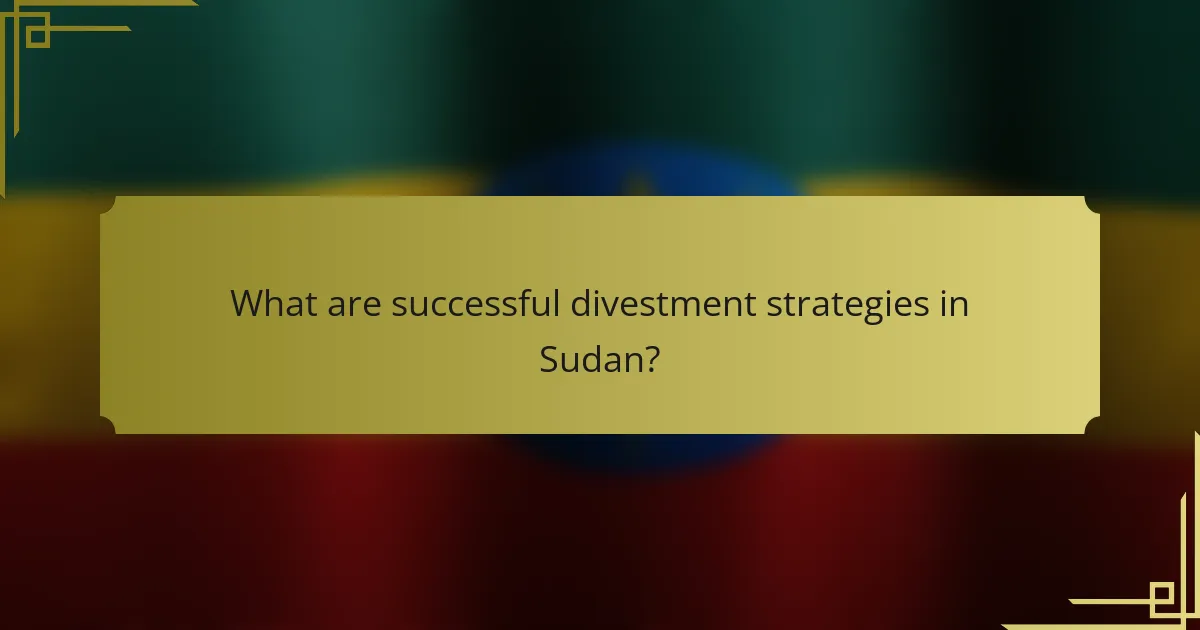
What are successful divestment strategies in Sudan?
It is challenging to identify successful divestment strategies in Sudan due to the complex political and economic landscape. However, some strategies have been noted for their effectiveness. Engaging in targeted sanctions against specific sectors, such as oil and arms, has been used to pressure the government. Mobilizing international coalitions to support divestment efforts can amplify impact. Campaigns that raise awareness among investors about human rights abuses have also proven effective. Additionally, leveraging legal frameworks to restrict investments in companies linked to violence or exploitation can lead to successful divestment. These strategies have been utilized by various organizations and movements advocating for change in Sudan.
How have divestment strategies evolved in Sudan?
Divestment strategies in Sudan have evolved significantly over the past two decades. Initially, divestment focused on foreign companies operating in Sudan’s oil sector. Activist groups targeted these companies to pressure them to withdraw due to human rights abuses.
In the 2000s, divestment campaigns gained momentum, particularly in response to the Darfur conflict. Universities and pension funds began divesting from Sudanese investments. This led to increased scrutiny of corporate involvement in Sudan.
By the 2010s, divestment strategies expanded beyond oil to include sectors like mining and telecommunications. The focus shifted to advocating for responsible investment practices.
Recent developments have seen a rise in targeted sanctions and selective divestment. These strategies aim to hold specific entities accountable while promoting sustainable business practices.
The evolution reflects a broader understanding of the complexities in Sudan’s political and economic landscape. Current divestment efforts emphasize collaboration with local communities and international organizations.
What historical factors have influenced divestment in Sudan?
Divestment in Sudan has been influenced by a combination of historical factors. The Darfur conflict, which began in 2003, prompted widespread international condemnation and calls for divestment from companies supporting the Sudanese government. Economic sanctions imposed by the United States in 1997 and expanded in 2006 further restricted investment opportunities. Additionally, the secession of South Sudan in 2011 affected Sudan’s oil revenues, leading to economic instability. Human rights abuses and ongoing conflicts have also deterred foreign investment. These factors collectively shaped the landscape for divestment in Sudan, driving corporations and investors to withdraw their support.
What role do international policies play in Sudan’s divestment strategies?
International policies significantly influence Sudan’s divestment strategies. These policies often promote economic sanctions and restrictions aimed at specific sectors. For instance, the United States has implemented sanctions targeting Sudan due to human rights violations. Such sanctions compel foreign investors to withdraw from Sudan, directly impacting its economy. Additionally, international policies can encourage divestment by creating a negative perception of Sudan in global markets. This leads to decreased foreign direct investment and increased pressure on local companies to divest from controversial sectors. Furthermore, international organizations may provide guidelines that shape Sudan’s compliance with global standards, affecting its investment climate. Overall, international policies play a critical role in shaping the landscape for divestment in Sudan.
What are the key components of successful divestment strategies?
Successful divestment strategies include clear objectives, stakeholder engagement, risk assessment, and effective communication. Clear objectives guide the divestment process. They ensure alignment with overall organizational goals. Stakeholder engagement is crucial for understanding concerns and gaining support. Engaging with stakeholders can lead to better outcomes and reduce resistance. Risk assessment identifies potential challenges and mitigates negative impacts. It allows organizations to prepare for unforeseen issues. Effective communication throughout the process builds transparency and trust. Communicating intentions and progress keeps all parties informed and involved. These components collectively enhance the likelihood of a successful divestment.
How do stakeholder engagement and advocacy impact divestment success?
Stakeholder engagement and advocacy significantly enhance divestment success by fostering collaboration and building support. Engaged stakeholders, including local communities and organizations, provide valuable insights and strengthen the legitimacy of divestment efforts. Advocacy amplifies these voices, creating pressure on decision-makers to act. Evidence shows that successful divestment campaigns often involve active participation from stakeholders. For instance, the Sudan divestment movement gained traction through organized efforts by activists and local groups, which raised awareness and mobilized public support. This collective action led to increased visibility and urgency around divestment goals, ultimately influencing policy changes and investment decisions.
What financial mechanisms are commonly used in divestment strategies?
Common financial mechanisms used in divestment strategies include direct divestment, shareholder resolutions, and engagement with companies. Direct divestment involves selling off investments in specific sectors or companies. This mechanism is often employed to avoid funding industries like fossil fuels or tobacco. Shareholder resolutions allow investors to propose changes in company practices. These resolutions can push companies towards more sustainable operations. Engagement involves dialogue with companies to influence their policies and practices. This approach seeks to encourage responsible behavior without divesting. Research shows that these mechanisms can effectively lead to significant changes in corporate behavior. For example, the Global Climate Action Summit highlighted successful divestment from fossil fuel companies by various institutions.
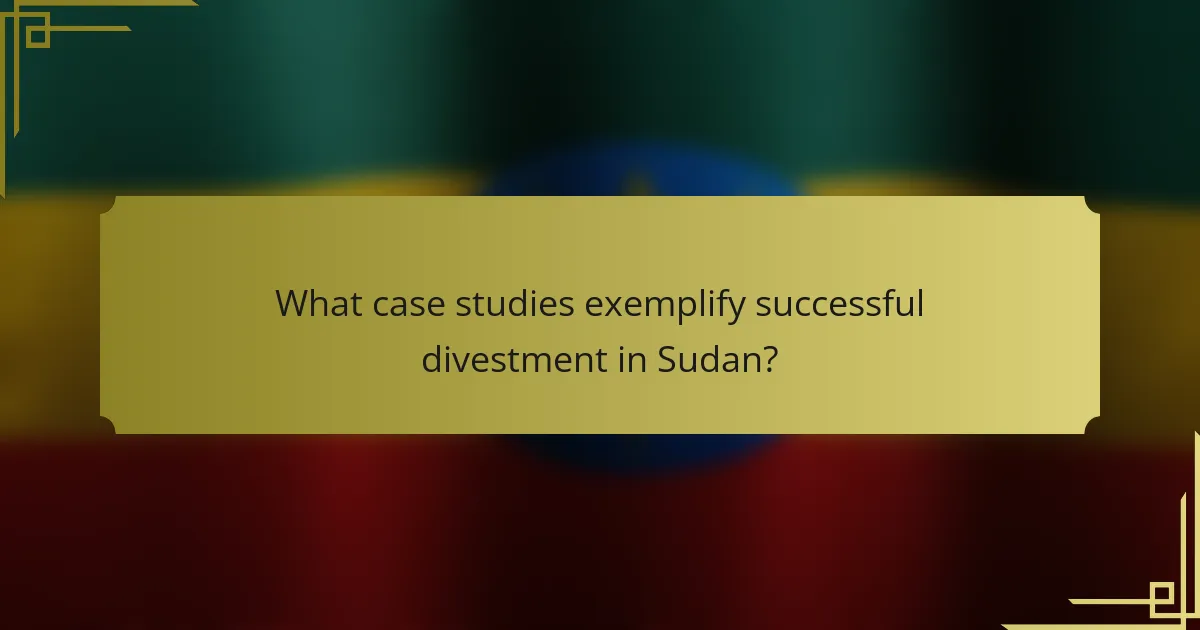
What case studies exemplify successful divestment in Sudan?
There are several case studies that exemplify successful divestment in Sudan. One notable example is the divestment campaign led by the Sudan Divestment Task Force. This initiative aimed to pressure companies to withdraw from Sudan due to human rights abuses linked to the Darfur conflict.
The campaign successfully encouraged numerous institutional investors to divest from companies operating in Sudan. As a result, several major financial institutions, including the University of California system, enacted divestment policies.
Another significant case is the divestment by the Norwegian government pension fund. This fund excluded companies involved in oil production in Sudan, citing ethical concerns. This action set a precedent for other funds to follow suit.
These case studies demonstrate effective strategies in leveraging economic pressure to influence corporate behavior regarding human rights in Sudan. The outcomes highlight the impact of coordinated divestment efforts in promoting social and ethical responsibility.
Which organizations have successfully implemented divestment strategies?
Several organizations have successfully implemented divestment strategies. Notable examples include the Norwegian Government Pension Fund Global, which divested from coal companies. The University of California system also enacted a divestment strategy from fossil fuels in 2013. Additionally, the [censured] of England has committed to divesting from fossil fuel companies. These organizations demonstrate effective divestment strategies aimed at promoting sustainability and ethical investment practices.
What specific outcomes were achieved by these organizations?
The specific outcomes achieved by these organizations include increased financial pressure on the Sudanese government. This pressure led to a reduction in military spending and a shift towards peace negotiations. Additionally, organizations reported improved human rights conditions in affected regions. There was also a significant rise in international awareness regarding the situation in Sudan. These outcomes were documented in various reports, highlighting the effectiveness of divestment as a strategy. For example, the Sudan Divestment Task Force reported a measurable decrease in foreign investments in the Sudanese oil sector.
How did these organizations overcome challenges during the divestment process?
Organizations overcame challenges during the divestment process by implementing strategic communication and stakeholder engagement. They actively informed stakeholders about the reasons for divestment. This transparency built trust and support among community members and investors. Additionally, organizations developed alternative investment strategies that aligned with ethical standards. They focused on sectors that fostered sustainable development. By collaborating with local partners, they navigated regulatory challenges effectively. These partnerships provided insights into local market dynamics and facilitated smoother transitions. Furthermore, organizations engaged in public advocacy to raise awareness about the impacts of their divestment decisions. This helped garner public support and mitigate backlash. Overall, these strategies collectively enabled organizations to successfully manage the complexities of divestment in Sudan.
What lessons can be learned from these case studies?
Lessons from the case studies of successful divestment strategies in Sudan include the importance of stakeholder engagement. Effective communication with local communities enhances trust and cooperation. Another lesson is the need for clear objectives and measurable outcomes. This ensures that divestment strategies are focused and results-oriented. Additionally, adaptability in strategies is crucial. Successful cases demonstrated responsiveness to changing political and economic contexts. Collaboration with international partners also proved beneficial. It provided resources and expertise that strengthened local initiatives. Lastly, maintaining transparency throughout the process fosters accountability and encourages broader support. These lessons emphasize the multifaceted approach required for effective divestment in complex environments like Sudan.
What best practices emerged from successful divestment strategies?
Successful divestment strategies often include clear communication, stakeholder engagement, and thorough research. Clear communication ensures that all parties understand the rationale behind divestment decisions. Stakeholder engagement fosters collaboration and support from affected communities. Thorough research helps identify viable alternatives and assess potential impacts. For example, the Sudanese divestment movement effectively utilized these practices to mobilize support. The Sudan Divestment Task Force highlighted the importance of transparency and accountability in its initiatives. These practices led to increased awareness and pressure on companies operating in conflict zones.
How can these lessons be applied to future divestment efforts in Sudan?
The lessons from previous divestment strategies can guide future efforts in Sudan. Emphasizing stakeholder engagement is crucial. Successful divestment involved collaboration with local communities and NGOs. Transparency in decision-making processes built trust. Data-driven approaches helped identify effective targets for divestment. Historical context of Sudan’s political landscape informs strategic timing. Monitoring and evaluation frameworks ensured accountability and adaptability. These elements collectively enhance the effectiveness of future divestment initiatives.
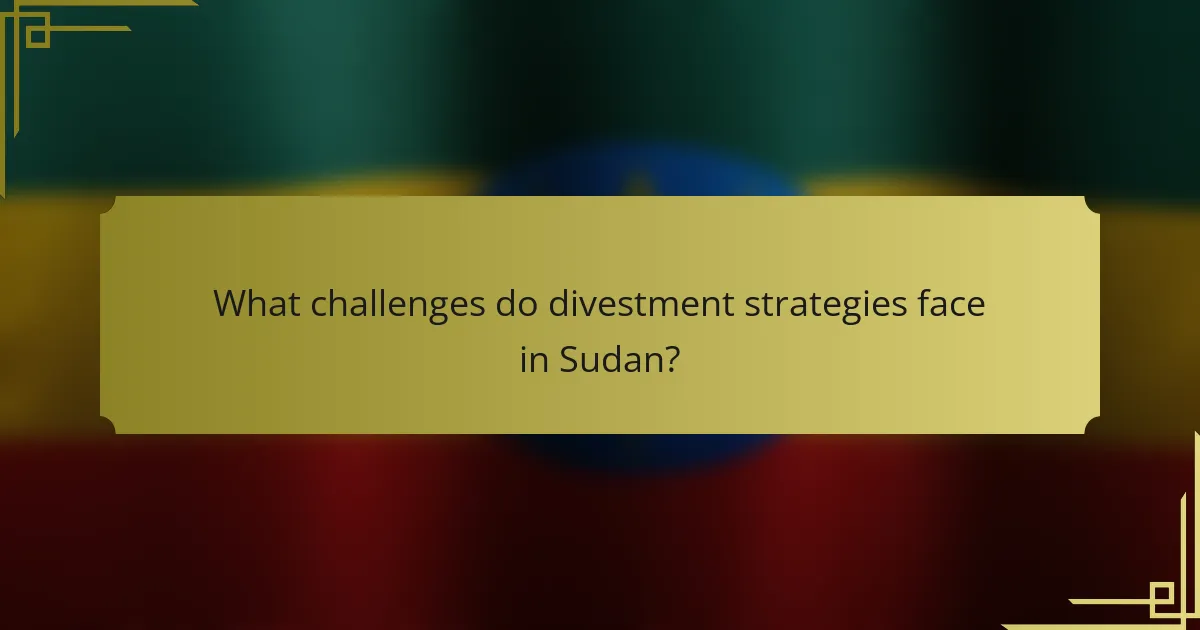
What challenges do divestment strategies face in Sudan?
Divestment strategies in Sudan face significant challenges. Political instability hinders consistent policy implementation. The lack of a stable legal framework complicates enforcement of divestment decisions. Corruption within institutions can undermine the efficacy of these strategies. Economic dependencies on certain sectors make divestment difficult. Additionally, the presence of armed conflict disrupts market operations. International sanctions may not be effectively enforced due to local dynamics. These factors collectively create a complex environment for divestment efforts in Sudan.
What are the primary obstacles to successful divestment in Sudan?
The primary obstacles to successful divestment in Sudan include political instability and lack of regulatory frameworks. Political instability creates an unpredictable environment for investors. This uncertainty discourages potential divestment efforts. Additionally, weak regulatory frameworks hinder effective implementation of divestment strategies. Without clear guidelines, companies face challenges in navigating the divestment process. Economic sanctions further complicate divestment efforts. They limit financial transactions and create barriers to exit. Moreover, the presence of entrenched interests in the economy can obstruct divestment initiatives. These factors collectively contribute to the difficulties faced in achieving successful divestment in Sudan.
How do political and economic instability affect divestment efforts?
Political and economic instability significantly hinder divestment efforts. Instability creates uncertainty, making investors wary of committing funds. This leads to decreased investment interest in affected regions. For instance, in Sudan, ongoing conflict and economic turmoil have deterred international businesses. As a result, divestment campaigns face challenges in mobilizing support. Historical data shows that companies often retreat from unstable markets to protect assets. Thus, political and economic conditions directly influence the feasibility and success of divestment initiatives.
What social factors complicate divestment strategies in Sudan?
Social factors complicating divestment strategies in Sudan include ethnic tensions and political instability. Ethnic diversity in Sudan leads to conflicting interests among various groups. Political instability creates an unpredictable environment for investors. Additionally, widespread poverty affects public perception of divestment. Local communities may view divestment as a loss of jobs and economic opportunities. Human rights issues further complicate the situation, as they can lead to international scrutiny. Activism against divestment can also emerge from local organizations. These factors collectively hinder effective divestment strategies in the region.
How can these challenges be addressed?
Addressing the challenges of divestment strategies in Sudan requires a multi-faceted approach. First, collaboration among stakeholders is essential. Engaging local communities, NGOs, and international organizations can create a supportive environment. Second, establishing clear legal frameworks can provide guidance and protection for divestment actions. This can enhance investor confidence and ensure compliance with local regulations. Third, conducting thorough risk assessments is crucial. Understanding the specific challenges in Sudan can help tailor strategies effectively. Fourth, leveraging international pressure can compel compliance from local governments and corporations. Historical instances, such as the divestment from South Africa during apartheid, show that global advocacy can lead to significant changes. Lastly, promoting transparency and accountability in financial dealings can mitigate corruption risks. These strategies collectively enhance the effectiveness of divestment initiatives in addressing the challenges present in Sudan.
What strategies have proven effective in overcoming divestment barriers?
Effective strategies for overcoming divestment barriers include stakeholder engagement, transparent communication, and policy advocacy. Stakeholder engagement fosters collaboration among investors, communities, and governments. Transparent communication builds trust and clarifies intentions, reducing misinformation. Policy advocacy promotes supportive regulations that facilitate divestment processes. Research shows that these strategies enhance cooperation and mitigate resistance. For instance, the Sudanese divestment movement successfully leveraged these tactics to mobilize support and navigate complex political landscapes.
What role do local communities play in facilitating successful divestment?
Local communities play a crucial role in facilitating successful divestment. They provide grassroots support and mobilization for divestment campaigns. Local communities raise awareness about the impacts of investments on their lives and environment. They often organize protests and community meetings to voice their concerns. This collective action creates pressure on decision-makers to consider divestment. Furthermore, local communities can offer alternative solutions and sustainable practices. Their involvement ensures that divestment aligns with local needs and priorities. Successful divestment strategies often hinge on the engagement of these communities, as seen in various case studies in Sudan.
What practical tips can be applied to divestment strategies in Sudan?
Identify key sectors for divestment in Sudan. Focus on industries linked to human rights violations or environmental degradation. Engage local stakeholders to understand the socio-economic impacts of divestment. Develop a clear communication strategy to inform stakeholders about the divestment process. Monitor and evaluate the impact of divestment on local communities. Ensure compliance with international standards and guidelines for ethical investment. Collaborate with NGOs and advocacy groups for support and guidance. Utilize data and research to back divestment decisions and strategies.
How can organizations effectively communicate their divestment goals?
Organizations can effectively communicate their divestment goals by developing clear, consistent messaging. They should define the specific reasons for divestment, such as ethical concerns or financial performance. Utilizing multiple communication channels is crucial. This includes press releases, social media, and stakeholder meetings. Engaging with stakeholders directly fosters transparency and trust. Providing regular updates on progress and outcomes reinforces commitment. Research shows that organizations with clear communication strategies enhance stakeholder understanding and support. A study by the Harvard Business Review indicates that effective communication increases the likelihood of successful divestment outcomes.
What are the key steps to ensure a successful divestment process?
Identify the objectives of the divestment. Clear goals guide the process. Conduct a thorough assessment of the assets involved. Understanding asset value is crucial for informed decisions. Develop a strategic divestment plan. This plan should outline timelines and responsible parties. Engage stakeholders early in the process. Their input can enhance the strategy’s effectiveness. Execute the divestment according to the established plan. Timely execution minimizes disruptions. Monitor the process closely for any issues. Adjust strategies as needed to address challenges. Evaluate the outcomes post-divestment. This assessment informs future divestment initiatives.
The main entity of the article is successful divestment strategies in Sudan. The article examines the evolution of these strategies, highlighting effective approaches such as targeted sanctions, international coalitions, and stakeholder engagement. It discusses historical influences, the role of international policies, and key components that contribute to successful divestment efforts. Additionally, the article presents case studies of organizations that have effectively implemented divestment strategies, the challenges faced, and best practices that emerged from these experiences. Insights on how local communities can facilitate divestment and practical tips for organizations are also provided.
